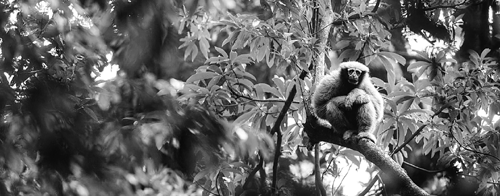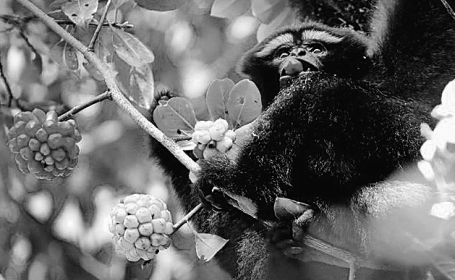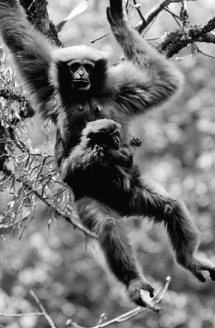Former hunter finds new life protecting gibbons
Endangered species first to be discovered and named 'Skywalker' by Chinese zoologists

Uncle Cai knows everything about the Gaoligong Mountains in Southwest China's Yunnan province, a range described by National Geographic magazine as an "ark of life", and home to evergreen broadleaved and deciduous forests, as well as bamboo woodlands.
"In the Gaoligong, Cai can tell you which route is a passage for wild animals with just a quick glance. He can tell an animal's gender and age by the sound of its voice and can guess their species and weight by analyzing its footprints," said Fan Pengfei, a professor at Sun Yat-Sen University in Guangzhou, Guangdong province. Fan has studied gibbons in Yunnan for over a decade.
"Uncle Cai", Cai Zhihong, is actually Fan's research partner. He is a forest ranger born in a small village at the foot of the Gaoligong, and one of those known for the discovery of a new species of primate known as the Skywalker hoolock gibbon (Hoolock Tianxing), the only gibbon species to have been named by Chinese scientists.
Since 2007, Fan's team has been studying eastern hoolocks (Hoolock leuconedys). After analyzing years of morphological and genetic information, and with the support of international colleagues and experts from the Chinese Academy of Sciences, they were able to classify eastern hoolocks living in the Gaoligong as a separate species, Skywalker (Tianxing) gibbon.
"We named them 'Tianxing' after a quote from an ancient Chinese classic, which says that 'as nature's movement is ever vigorous, so must a gentleman ceaselessly strive'," Fan explained.
"This hoolock gibbon spends nearly its entire life in the upper levels of the forest, like a hermit walking across the sky."
Cai played a crucial role in their discovery. He and the other rangers have spent years in the forests, working 25 days a month, chasing after the gibbons and gathering field observations and fecal samples.
In 2019, the International Union for Conservation of Nature added the Skywalker gibbon to its Red List as an endangered species.
With an estimated population of less than 150 in the wild, it is also among the world's 25 most endangered primates.
Rich biodiversity
As the southeastern arm of the Himalayas, the Gaoligong extend for nearly 500 kilometers and reach an altitude of 4,876 meters. They are home to the world's highest-elevation and highest-latitude tropical rainforests. Though mostly situated in China's Yunnan province, they also extend northward into Myanmar.
The mountains are home to more than 700 animals and about 5,000 plant species, making this tiny sliver of China one of the country's most biodiverse areas.
The Gaoligong are also the only place in China where a Skywalker gibbon presence has been confirmed. Most are believed to live on the Myanmar side of the mountain range, but to date opportunities to survey the species' distribution in wider areas have been scant.
According to Jiang Xuelong, a researcher at the Kunming Institute of Zoology under the Chinese Academy of Sciences, who also participated in the study, the Skywalker population has been threatened by multiple factors in recent decades, including logging, the expansion of human settlements, climate change and habitat loss.
Like other gibbons, Skywalkers have no tail. They are covered in short fur, almost jet-black on males and beige on the females, and their most distinctive characteristics are thin white eyebrows and darker beards.
"Gibbons spend their lives high up in the treetops and are very good at swinging. They use their long arms for balance when navigating, and it makes scientific research incredibly hard," Jiang said, showing his right leg, which was broken earlier this year after a fall during field research.
A good partner who knows the forest better than anyone else is an important help. Cai, who grew up in the Gaoligong and is an experienced hunter, quickly became the best candidate.
"I am a campus professor and Cai is a Gaoligong 'professor'," Fan joked, calling Cai a "walking map of the Gaoligong".
Born in 1970, Cai learned to hunt with his grandfather. "When I was a teenager, I took my grandfather's gun and hunted for wild animals nearly every day. Life was very hard at the time, and we only hunted for food," he said.
He sees the mountains and its animals as part of his life. "But we don't hunt gibbons," he added. As a member of the Lisu ethnic group, Cai said his culture maintains strong generational taboos against the hunting of gibbons.
"We believe they are primate gods that can foretell the weather or even a death with their singing, and that killing them brings misfortune on hunters' families or even the village," he explained.
Isolation causes problems
As China has paid more attention to environmental protection in recent decades, instituting bans on hunting guns and commercial logging, many mountainous areas have developed policies to encourage local residents to participate in wildlife protection.
In 1983, Yunnan announced it was turning the Gaoligong range into a provincial-level nature reserve and upgraded it to state level three years later.
In 1997, the mountains were recognized as a UNESCO Biosphere Reserve. The following year, Cai became a forest ranger, and the former hunter completely changed his way of life.
"Unprovoked animals rarely attack human beings. As we enjoy a more prosperous life by protecting the mountains and the animals, we should live with them in harmony," he said.
Cai has been part of the gibbon research team since 2011. His understanding of the environment makes him all the more important. "He is not just a treasure trove of information on local wildlife, he's also our most trusted guide," Jiang said.
By relying on his experience, Cai helps locate the gibbons and collect information about their daily activities-a tough job that is very physically demanding. In 2019 alone, he spent 300 days in the forest and walked more than 3,000 km.
"In the deep forest, communication with the outside world is difficult to maintain, which means gibbon chasers have to be able to tolerate loneliness. Records of gibbon activities have to be kept regularly, so you also have to be able to keep up with them physically," Cai said.
He wasn't part of the team at the start. "I turned down their invitation because I wasn't confident I'd be able to do the work, given my limited educational background," he said. "But the other two rangers both quit soon after joining because of the stressful routine. So finally, I joined."
Daily work starts at 4 am, before the gibbons wake up. Usually, Cai has to find where they stopped the day before and spend the night in the forest with them.
"I can't stop recording, even in the rainy season. Then, the gibbons are usually active up to 12 hours a day, and I have to keep following them," he said.
"To get precise measurements of temperature and light, I sometimes have to climb to the top of the trees, which are about 20 meters above the ground, without any protection."
Better information
More challenging still is building trust between humans and gibbons, a scientific process known as "accustomization".
"Gibbons are alert to human activity, so it's been very difficult to get close to them," said Jiang, who explained that the easiest way for scientists to calculate a population's size is by monitoring their songs, which often last up to 30 minutes and can be heard from more than a mile away.
"Making ourselves part of the forest is the path to success," Cai said. After observing the gibbons for just over five years, the team has successfully accustomized three groups of Skywalkers through unstinting daily efforts.
Despite earning a modest income of about 2,100 yuan ($329) per month, Cai said the conservation of Gaoligong and its wildlife makes his life meaningful.
"When I hear the sounds of the animals in the mountains, I feel like I'm a child again," he said. "The Gaoligong are the mother mountains to me. I will protect them until the day I can no longer move."
Although commercial logging has been banned across China since 2017 and awareness of wildlife protection has greatly improved, Jiang said that Gaoligong's gibbons are still threatened by small-scale habitat loss, degradation and fragmentation.
"They are separated by impassable stretches of agricultural land and towns, 60 km to 100 km wide and devoid of contiguous forest. Within the subpopulations, many family groups and individuals are isolated. This makes it even more difficult for them to breed and share genes, further threatening the future of the species," he said.
Since June, the Dehong Dai and Jingpo autonomous prefecture forestry department, where the Skywalker habitat is located, has been running a surveillance program to uncover more detailed information on the region's gibbon families.
"Only with a deeper understanding of the species, can we draw up a more comprehensive protection plan for them and save this endangered species from extinction. As Cai always says, we share the same goal of saving the Skywalkers for future generations," Jiang said.






Today's Top News
- China completes first landing, takeoff test of manned lunar lander
- China's new free preschool policy to save families $2.8 billion
- China's foreign trade rises 3.5% in first seven months
- China's foreign trade up 3.5% in first seven months
- 25-yuan roast duck reflects progress of rural vitalization
- Xi set stage for rise of cultural powerhouse






























